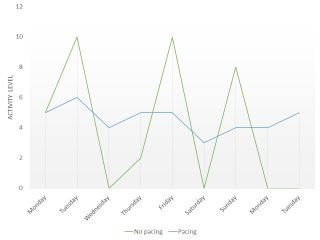Cognitive Behavioral Therapy
Myths and Facts About Pacing for Medical Illness
Learning how to right-size your activity level.
Posted July 17, 2023 Reviewed by Kaja Perina
Key points
- Pacing involves both being more and less active.
- Pacing can be helpful for those with chronic medical conditions.
- Pacing can also be helpful in thinking about one's expenditure of mental energy.
One of the most confusing facts about cognitive behavioral therapy is that it can be used for treating medical illnesses, such as fatigue in cancer. People assume cognitive behavioral therapy is only for mental health concerns where emotions and mood are the primary problems. However, cognitive behavioral therapy has been shown in numerous studies to help people cope with and manage their chronic medical conditions. One technique is called pacing.
Pacing is very accurately named because it involves pacing one’s level of activity. The idea is to avoid extremes of activity. The graph shows an example of "not pacing" in green. The person in green might feel really good one day (maybe their pain is low) so they try and cram as much as possible into that day. But they pay for it the next day and do very little. This pattern repeats and over time the person in green will become less and less active, often giving up what they most love. Pacing means following the blue line as closely as possible.
So our person having a good day with low pain might still be more active than the day before but they limit their activity to six hours instead of 10. Over time, they actually have better pain control and often more hours of meaningful activity. Exactly where the blue line will sit differs for each person and one person might manage 2 hours of activity a day while another can manage 12 hours. Where the blue line sits can also change over time for someone. One year they may be able manage 10 hours of activity a day and the next year it could be closer to five hours. The goal of pacing is to figure out a person’s current baseline and then work on maintaining a more stable or moderate level of activity.

Oftentimes the other techniques of cognitive behavioral therapy can help a person learn to pace. The cognitive techniques can be used to challenge assumptions about how productive a person should be or the ways in which people should be productive. These negative automatic thoughts about productivity often drive people to push themselves too much or too little rather than pacing.
An important part of cognitive behavioral therapy is becoming more aware of one’s emotions and this increase in awareness can be transferred to physical symptoms such as pain and fatigue. This awareness can then be used to guide pacing so that a person maintains some activity level but does not push themselves too hard.
Dispelling Myths
The first myth is that pacing is just energy conservation. Energy conservation is, as the name implies, when a person purposefully does not use up energy. While energy conservation can be helpful in conjunction with pacing, the two techniques are different. Energy conservation can involve developing strategies to use less energy on less important tasks, such as collecting things that need to go upstairs throughout the day and making one trip instead of multiple trips a day. In pacing, the person would make one or multiple trips depending on whether they are trying to be more or less active that day. Energy conservation can be helpful on days that a person needs to be less active but pacing takes a more balanced view of trying to moderate activity.
Another myth is that pacing only works for physical energy. However, it can be quite helpful for mental energy and, for people who are introverted, social energy. People have different capacities for different activities and while one might be able to run a mile right now, they might not be able to make small talk. Using the concept of pacing and one’s own personal baseline can be helpful for managing both physical and mental health conditions. Even people without physical or mental health conditions can benefit from the concept of pacing.

Another myth is that pacing can cure peoples’ arthritis or other health condition. I honestly wish this was true but sadly it is not. Pacing is a technique for managing medical and mental health conditions. But pacing cannot cure someone’s illness. It is possible that pacing might make it seem like a person is “cured” or no longer has the condition but the person has to maintain the pacing to stay that way. Pacing is not like a course of antibiotics where someone just takes it for a while and then they are no longer sick.
Pacing is an important part of the behavioral side of cognitive behavioral therapy, particularly for people with chronic medical conditions. Pacing can be done on its own but it is often helpful to have a therapist provide guidance and an outside perspective. Remembering how much energy was used up by what activity can be challenging and having another person can help a person be successful.


